Kiran Manral's Blog, page 29
June 3, 2016
In the Scroll, The Face At The Window
Conventional wisdom had it that only men could write adrenaline-pumping books.
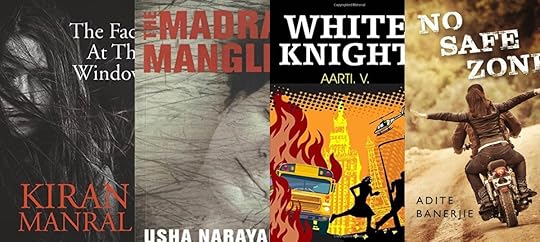
3 hours ago
Adite Banerjie
What’s it about a James Patterson, John Grisham, Robert Ludlum, Ashwin Sanghi or Mukul Deva that has intense appeal among readers of crime and thriller fiction? Browsing at bookstores I have often wondered why women writers have failed to make a lasting impact on the genre. Is it that the testosterone-driven guns-guts-and-glory plotlines hold little appeal to women readers and writers?
Well, not really. As a reader – and a woman – I have enjoyed the antics of Perry Mason, Jason Bourne and Jack Reacher. My bookshelves have always boasted a wide variety of authors who specialise in the genre, including the Grande Dame of crime fiction, Agatha Christie. And as a writer, I have always wanted to write heart-pumping, edge of the seat action, and finally got a chance to do it with my romantic-thriller No Safe Zone.
So, much like a Hercule Poirot, I set off to investigate the mystery of why only a handful of women authors – primary among them being Christie, Daphne Du Maurier, Ruth Rendell, PD James, Sue Grafton – have scaled the heights of popular crime fiction and endured. To my pleasant surprise, the tide seems to be turning.
The spectacular success of Gone Girl by Gillian Flynn and Girl on the Train by Paula Hawkins has established that contemporary women writers can plot diabolical twists as effectively as any of their male counterparts. What’s more, as the genre has expanded from the Christie-esque living-room murder mysteries to include psychological thrillers, romantic-suspense, paranormal suspense, spy thrillers and more, women are increasingly bringing in their unique take.
As critic Laura Miller recently observed in Salon, “Their (women authors’) prose ranges from the matter-of-fact to the intoxicating, and the battlefields they depict are not the sleazy nightclubs, back alleys, diners and shabby offices of the archetypal PI novel, but a far more intimate and treacherous terrain: family, marriage, friendship.”
Thrillers, but three-dimensional
While plot is the real “hero” of crime fiction, there is no doubt that women writers are introducing three-dimensional characters and making thrillers more nuanced reads. As Kiran Manral, author of The Face at the Window, a paranormal thriller, says, “The female gaze is relentless, unflinching and does not take excuses. It is also empathetic, and delves more into the inner conflict that makes up as much of the drama as the external. It might be grittier, but it is more interior a journey for the reader. Women also experience violence – or perhaps the constant implied threat of violence – differently and more intensely than men, I think, and that emerges in the writing.”
Adds Usha Narayanan, author of The Madras Mangler, “The perception that women cannot write thrillers probably springs from the assumption that these books call for more violent scenes and characters than, say, a rom-com. But violence is very much a part of our lives today and our writing. Perhaps what women can add to the genre is a greater insight into the emotions and the motivations that underlie actions.”
What about pulse-pounding action scenes? How well do women writers tackle those? Argues Mukul Deva, the best-selling author of several military-ops thrillers like Lashkar and Salim Must Die, “Whether written by male or female, the guns, guts and glory type of thrillers are most gritty and realistic when they come from a writer who has had some exposure to this – say in the armed forces, the police, or some law enforcement, security, intelligence background. These tend to be more male than female.”
Aarti V Raman, who has written two thrillers – White Knight and Kingdom Come – disagrees. “It’s not as if women thriller writers do not put in the same amount of research or figure out the exact terminology that is used in military ops or a similar space. The difference, if there is any, is probably in the way the plots are twisted in the narrative and the amount of detail that sometimes is given to technicalities (yes, I am talking about Dan Brown in Deception Point).”
Pushing the borders
Interestingly, it’s women writers who’re leading the way into unexplored territory. As Raman points out, “In India, where college romances and histo-mytho sagas rule the bookshelves, people are attempting new styles of writing. They are subverting culture and taking on taboos inherent in society.”
It’s not surprising then to find women writers experimenting with genres or sub-genres. Those who write love stories are writing about guns and car chases, and vice-versa. A key reason for this “freedom”, avers Raman, is that “worries such as ‘what will my publisher think about this?’ or ‘will my agent approve?’ have been replaced with Amazon Kindle Publishing and other services. If your publisher or agent doesn’t like what you’re writing, you can always take it to the market yourself.”
Even so, concerns about how readers will react to a thriller written by a woman cannot be totally wished away. Call it marketplace reality. Admits Narayanan, “Initially, I was not too sure how Indian audiences would receive a thriller written by a female, and even considered using a male pseudonym. However, the book was released under my name and readers overwhelmed me with their discernment and praise.”
In fact, unlike their male counterparts, women writers are not afraid of giving their loyal readers a bit of a scare. Says Manral, “The Face at the Window has quite shaken my readers – my previous books have been happy, funny, romantic reads. After the initial moment of disbelief that I could have written this dark, grim, terrifying book, they’ve enjoyed reading it; so that’s a relief.”
As women delve deeper into the fictional arena of crime, murder and all things gory offering readers a wider choice of stories, it is inevitable that the gender of the writer will cease to matter. Says Deva, “Any writer can do any genre effectively, should they wish to. Just to test this out, one of these days, I plan to do a romantic, mystery novel.”
In fact, the real takeaway from a thriller for readers may not even be the action. Says Manral, “Crime and thrillers are in some way our modern day equivalent of fairy tales. We are looking for a peak of some sort of fear catharsis in the reading of these and the assurance that things will be set right by the end of it all.”
Adite Banerjie is an author and screenwriter. Her newest release is No Safe Zone, a romantic-thriller published by Harper Collins India.
Read the original here


June 1, 2016
So, how does a shrinking violet like me, get up and speak in public?
I just came off a very interesting twitter chat of public speaking and women for an initiative called No More Manels that attempts to get more women up there, speaking, at events, panels, conferences.
It is strange, that someone like me could be asked for my tips on public speaking, given my natural inclination is to shut myself in a box and never emerge into civilisation if I had the choice. But I do get out there, up there, and do my fair share of speaking, so here it is, what I would like to share with every woman looking to go up on stage and speak:
It isn’t easy for me to get up there on panels, at speaker podiums, at lit fests and book launches and speak to an audience. I am a pretty confident person but public speaking always fazes me. This is probably because intrinsically I am basically terribly introverted. I owe my getting out of my comfort zone and accepting invitations to speak to the very wonderful Tisca Chopra who once sternly told me in a pep talk that I so needed that I must stop being a shrinking violet, and stop turning down opportunities to speak in public. So now I do. No matter how uncomfortable it makes me feel. There is the clammy sweaty palms, the twisted intestines, physical nausea at times, trembling limbs at others, but I push myself to go up there and say my bit.
I deal with it by telling myself I have to get up there and speak and I have absolutely no option and that I can go hide behind a pillar once I’m done. If it is a book launch, I try to get there ahead of time and go shake hands and introduce myself to every single person attending. That way, I feel I know them when I’m up front talking to them, and it feels friendlier. Sometimes when it is a huge audience, or when I cannot mingle with the audience before hand, I try to find one or two faces in the audience who seem kindly and the least likely to throw tomatoes at me, and focus my talk at them. Or I spend a few seconds looking at each member of the audience in the eye as I speak and try to forge a connect with them, however momentary.
I also have a little routine that I do, I either read something funny, or I chant or meditate for a bit. Or if I have enough time before leaving for an event, I go for a short walk. I find physical movement dissipates the excess nervous energy and helps me feel calmer. Just before going on, I say something positive to myself, perhaps, “Go rock it now,” and plaster a huge smile on my face.
I never ever allow myself to show if I am tired, sleepy, unwell or sad if I am on stage or panel. That’s not what the audience came for. When I’m on, I’m all on. I will get up there and smile, and be all flash and dazzle. I will collapse once I’m out of the venue and in the car back home.
I find it helps to begin with a space of gratitude for the kind people who have invited one, for those who have taken time out to listen to what one has to say.
Dressing up is always respectful to my audience and I try to not be too shoddily turned out. I find high heels help me feel more confident (perhaps because I’m pretty conscious of being short) and find dressing up also therapeutic in a way, because I when I know I am presentable, I can focus on the talk without being worried that I’m looking like a disaster to the audience. Also, knowing that one is presentable and looking fairly decent is a confidence bolster until the nerves finally settle.
Then there are the other non negotiables.
I ONLY accept invites to speak on topics I am informed about and bring something to the table about. I will not go and speak on something I have little or no knowledge about. My other non negotiable is to know what I am speaking about, to read up as much as I can before the event. (Of course, if I do get a question I know nothing about, I am always honest enough to say that I do not know enough to answer that, and hope the person who asks it appreciates my reply).
Then there is research on the topic, and writing out what one wants to say, and rehearsing it. Over and over again, so that the words flow naturally from me, so even if a malfunctioning projector or some wires misbehaving makes the carefully prepared presentation redundant, I should be able to go through the main points from the points in my head.
I also find it helps to research the audience. Find a common ground and pitch it from there. Begin a conversation with the audience, they are not adversaries, they are there to listen to one, to get informed, to get a takeaway that would make them feel that this was worth it. I try to get people to respond, throw in questions or take questions from the audience, even if they come within the presentation or the talk, no matter that it breaks the flow. I believe that one needs to respect the audience. They have taken time out from their lives to come to listen to one. One owes them preparedness on the subject matter and a talk that adds value to their lives whether professional or personal.
If I have an opinion on a topic, it will be an informed one so I can defend it if needed. I must come from a space of informed opinion. I can’t and don’t even try to be an expert on everything.
Another rule by me, is to not be rude, no matter how provoked, to not cut in into someone else speaking no matter how much I want to contradict what they’re saying, and don’t ever cut someone else down in public. Do that and you’ve made an enemy for life, and the audience sees through these attention grabbing stunts.
I try to stay calm and centred, and speak slowly when I’m gathering my thoughts, if I blank out, I smile broadly and talk about some anecdote I can rustle off the top of my head, until my thread of thought comes back.
Sometimes there aren’t any questions after a talk but I’ve swamped off stage by folks who want to ask the questions one on one, so I keep it easy. I say if there are any questions now I’d be delighted to take them or I’m right here for a while if you want to speak with me later. Think about it, how many of us actually put our hand up after a talk to ask questions.
And yes, always the thank yous. To the organisers, the moderators, the co-panelists and the audience.


May 30, 2016
Some pics from a shoot I did yesterday for The Tara Sharma Show..
It’s always fun shooting for Tara Sharma’s show. For one, everything is organised seamlessly, so there’s always someone to meet you, take you to make up and hair, figure out clothes and stuff, and no endless waiting. The second, and to me, the most important bit is that everyone is smiling and happy.
Tara too, is warmth and sunshine and genuine and this trickles down to the entire team I guess. Here then are some pictures from the shoot. I was part of a panel on Gender Diversity, and spoke as a parent bringing up a boy.
With me were Anjali Gulati, founder of Back 2 The Front and Vishal Nongbet, COO of Superfry. And also, was delighted to finally meet Prerana Langa of Yes Foundation and Shalini Kamath of Ambit.
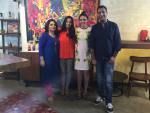
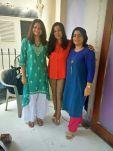
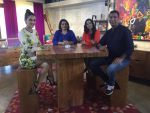


May 26, 2016
A little mention in this article on Marquez in The Week…
May 23, 2016
So what did the feminist movement get us, given so many women don’t want it?
(Disclaimer right up front. Am no academic, so if there are factual errors anywhere, do point them out, would be delighted to rectify them.)
Here’s a quick and easy primer.
The feminist movement is popularly divided into three waves.
This was what happened in the first wave:
(From Wikipedia).”First-wave feminism was oriented around the station of middle- or upper-class white women and involved suffrage and political equality.”
From Gender Cawater Info.net. “First-wave feminism refers to an extended period of feminist activity during the nineteenth century and early twentieth century in the United Kingdom and the United States. Originally it focused on the promotion of equal contract and property rights for women and the opposition to chattel marriage and ownership of married women (and their children) by their husbands. However, by the end of the nineteenth century, activism focused primarily on gaining political power, particularly the right of women’s suffrage. Yet, feminists such as Voltairine de Cleyre and Margaret Sanger were still active in campaigning for women’s sexual, reproductive, and economic rights at this time. In 1854, Florence Nightingale established female nurses as adjuncts to the military.”
Which, in simple terms means that the first wave of the feminist movement fought for a woman’s right to be a political equal to men, and for her right to vote in a democracy, as well as the right to be an equal in a marriage, and the right to own property.
In the second wave of feminism.
(From Wikipedia) Second-wave feminism attempted to further combat social and cultural inequalities.
“second-wave feminism broadened the debate to a wide range of issues: sexuality, family, the workplace, reproductive rights, de facto inequalities, and official legal inequalities.[4] Second-wave feminism also drew attention to domestic violence and marital rape issues, establishment of rape crisis and battered women’s shelters, and changes in custody and divorce law.”
Without second wave feminism, women would not have had the right to equal pay for equal work, right to property, reproductive rights over their own body. And there would be no redressal for domestic violence. The introduction of the oral contraceptive pill, gave women the option to delay and space pregnancies and so be able to focus on their career if they so desired.
Also, Betty Friedan’s book, The Feminine Mystique, made women question the myth of domestic happiness they had been fed all their lives.
“In 1963 Betty Friedan, influenced by The Second Sex, wrote the bestselling book The Feminine Mystique. Discussing primarily white women, she explicitly objected to how women were depicted in the mainstream media, and how placing them at home limited their possibilities and wasted potential. Friedan described this as “The Problem That Has No Name”.[20] The perfect nuclear family image depicted and strongly marketed at the time, she wrote, did not reflect happiness and was rather degrading for women.[21] This book is widely credited with having begun second-wave feminism.[22]“
The second wave of feminism also looked at how women were depicted in pop culture, rather anachronistic given that we still have hoes and bitches in popular songs.
“Second-wave feminists viewed popular culture as sexist, and created pop culture of their own to counteract this. Australian artist Helen Reddy‘s song “I Am Woman” played a large role in popular culture and became a feminist anthem; Reddy came to be known as a “feminist poster girl” or a “feminist icon”.[43][44][45][46][47][48][49] “One project of second wave feminism was to create ‘positive’ images of women, to act as a counterweight to the dominant images circulating in popular culture and to raise women’s consciousness of their oppressions.” [50]“
In the Third Wave of Feminism.
(From Wikipedia) Third-wave feminism is continuing to address the financial, social and cultural inequalities and includes renewed campaigning for greater influence of women in politics and media. In reaction to political activism, feminists have also had to maintain focus on women’s reproductive rights, such as the right to abortion.
“Gender violence has become a central issue for third-wave feminists. Organizations such as V-Day have formed with the goal of ending gender violence, and artistic expressions such as The Vagina Monologues have generated awareness and action around issues relating to women’s sexuality. Third-wave feminists want to transform the traditional notions of sexuality and embrace “an exploration of women’s feelings about sexuality that included vagina-centred topics as diverse as orgasm, birth, and rape.”[32]
“Third-wave feminism regards race, social class, transgender rights, and sexual liberation as central issues. However, it also pays attention to workplace matters such as the glass ceiling, sexual harassment, unfair maternity-leave policies,[49] motherhood – support for single mothers by means of welfare and child care and respect for working mothers and for mothers who decide to leave their careers to raise their children full-time.”
Third wave feminism gave us Slut Walks across the world, a reclaiming of the derogatory terms used against women, increased focus on women’s reproductive rights, fous on issues like single motherhood, the glass ceiling, sexual harassment policies and more.
And yes, there is a fourth wave of feminism, which began some years ago
From Wikipedia. “Fourth wave feminism is often associated with online feminism, especially using Facebook, Twitter, Instagram, YouTube, Tumblr, and other forms of social media to discuss, uplift, and activate gender equality and social justice.[6] According to NOW Toronto, the internet has created a “call-out” culture, in which sexism or misogyny can be called out and challenged immediately with relative ease.[7] This culture is indicative of the continuing influence of the third wave, with its focus on micro-politics and challenging sexism and misogyny insofar as they appear in everyday rhetoric, advertising, film, television and literature, the media, and so on.[8] This online feminism aspect of the fourth wave has impacted how companies market to women so that they are not “called out” for sexism in their marketing strategies.[“
And there are various branches of feminism, which include socialist and Marxist, black feminism, post colonial and more.
The bottom line though, is that feminism as a movement has been what has got us many of the rights we take so for granted today. All feminism aims at is simply gender equality in a society that has been overwhelmingly patriarchal all down the centuries.
And we continue to need it. We still have reports where women are paid less than men, 27 % at last reading, where marital rape is still not recognised as a crime by law, where women must fight to shatter the glass ceiling at work, where reproductive rights are still hard to come by for women in the hinterland.
Let’s not confuse feminism with misandry, please. And just let’s just recognise feminism for what it is. A movement that recognises the fact that women hold up half the sky.
For more on feminism read this: http://www.gender.cawater-info.net/knowledge_base/rubricator/feminism_e.htm


May 22, 2016
Win a pair of Miami Blues sunglasses, tell me the spookiest experience you’ve had #TheFaceAtTheWindow
I haven’t had a giveaway on my blog for yonks, so here’s one! As you might know, my latest book, The Face At The Window, is a bit of a spooky book. Here’s a bit about it.
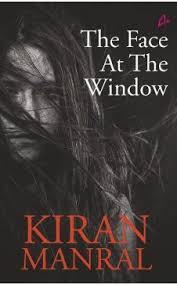
What if at the end of one’s life, one realises that one has lived out a lie?
Mrs McNally, a retired school teacher, living alone in a cottage at the foothills of the Himalayas, has secrets that if revealed could shatter the two people she cares about the most, her daughter Millie and her grand daughter Nina.
Torn by her desire to reveal the truth that could change Millie’s life, and the need to let things continue as they are, Mrs McNally grapples not just with ghosts from her past, but also a strange, vicious presence in her house that seems to want something from her. Will she ever find the peace that eludes her, will she be rid of this entity haunting her house and, more importantly, will she find closure? A gently nuanced, layered story that deals with the lack of identity and an eternal finding of self, The Face at the Window holds a mirror to the fears we are all afraid to voice, the fear of ageing, the fear of not belonging, and above all, the fear of having no one to love you at the end of your life.
I’m giving away two of these fabulous Miami Blues sunglasses to two bloggers who write a post on their spookiest experience.
Miami Blues is a homegrown sunglass brand which has recently relaunched with new styles, affordable prices and retails from Shoppers Stop, Lifestyle, Westside, Pantaloons and Central.

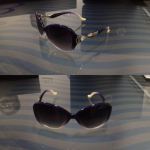

All you need to do is write your post, post a link in the comments section and don’t forget to post a link to this post in your post, mentioning that it is an entry for #TheFaceAtTheWindow Miami Blues Contest. Contest ends June 6, 2016. Go ahead, bring out your spooky stories. Scare me.


May 19, 2016
AUTHOR KIRAN MANRAL’S BOOKREADING
Yesterday evening I did not visit a cafe or a friend’s place or go out with my family like I usually do. It was a different and yes, a wonderful Sunday evening. I am an avid reader and I usually finish reading a book in two days so when my summer hols began, I knew that a library card was what I needed. JUST BOOKS, the library where I romance with fictional characters and gain inspiration from autobiographies, had made all of us readers and writers overjoyed by calling author Kiran Manral for her book reading. Let me be completely honest, her name wasn’t really on my reading list but I knew that meeting an author and hearing her read would make my soul happy. So, sharp at 5:3o my friend and I, we reached the library and she was standing inside with a few other people. Hair tied in…
View original post 327 more words


May 15, 2016
A reading from The Face At The Window at Just Books Thane
A lovely reading to a packed house at Just Books Thane, yesterday. Thanks Bhanumati Ganesh for inviting me, Sunita Saldanha for moderating the session, Archana Pai Kulkarni for reading from the book and Nilima Mohite for the pics.
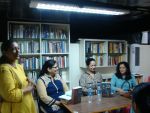
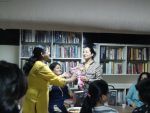
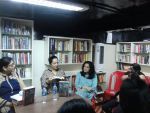
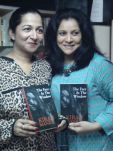
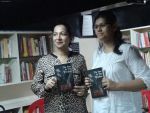


May 11, 2016
Announcing #INarrate essays from the Women Unlimited Series of the Taj Colloquium
A project that is very dear to my heart has just taken off and I am most delighted to share details about it with you.
Under the aegis of the Taj Colloquium, founded by Sumant Batra and Dr Shivani Chaturvedi, the Women Unlimited Series launched its first initiative #INarrate, yesterday.
Here’s a bit more about the Women Unlimited Series:
The social and economic development of women is deeply intertwined. It is imperative that women participate in debate and plays a pro-active and meaningful role in decision-making processes of issues that impact their quality of life and that of the communities they live in. The private sector should emerge as a key partner in this effort.
Women Unlimited Series Forum is an initiative of NHP Centre, for inclusion of women’s talents, skills and energies in various creative programmes of the NHP Centre and the Taj Colloquium Foundation.
I am honoured to have the opportunity to work with a fabulous steering committee, on this. The steering committee of the Women Unlimited Series includes Nishtha Satyam head Strategic Partnerships, Policy Impact and Public Relations for UN Women, Shaili Chopra founder ShethePeople.tv, Atiya Zaidi Publisher Ratna Sagar, Namita Bhandare eminent journalist and consulting editor on gender with Mint, Dr Debotri Dhar Lecturer in Women’s Studies at the University of Michigan, Ann Arbor, USA, and Jeanne Campbell Visiting Scholar at its Center for the Education of Women and Rakhee Bakshee Director Women ‘s Feature Service on this initiative.
#INarrate
#INarrate is an essay series (blogs) on the shifting narrative of a woman’s journey. Starting this week, popular contemporary women authors will be invited to contribute essays on the issues compelling the modern Indian woman to redefine herself. Contribution to #INarrate is “by invitation” only.
A series of essays from popular contemporary authors on the issues that are compelling Indian women to redefine their journeys, these are available at the #INarrate blog right here.
The first two essays, by Koral Dasgupta and Sujata Parashar are already up.


May 9, 2016
Speed Networking Sutra event with JAMMs Moms and Koffee Place
Was a speaker at the Speed Networking Sutra event last week, organised by Koffee Place and Jamm’s Moms Network, along with Ritu Soni Shrivastava, the founder of Obino, a weightloss app. Some pics from the event.












